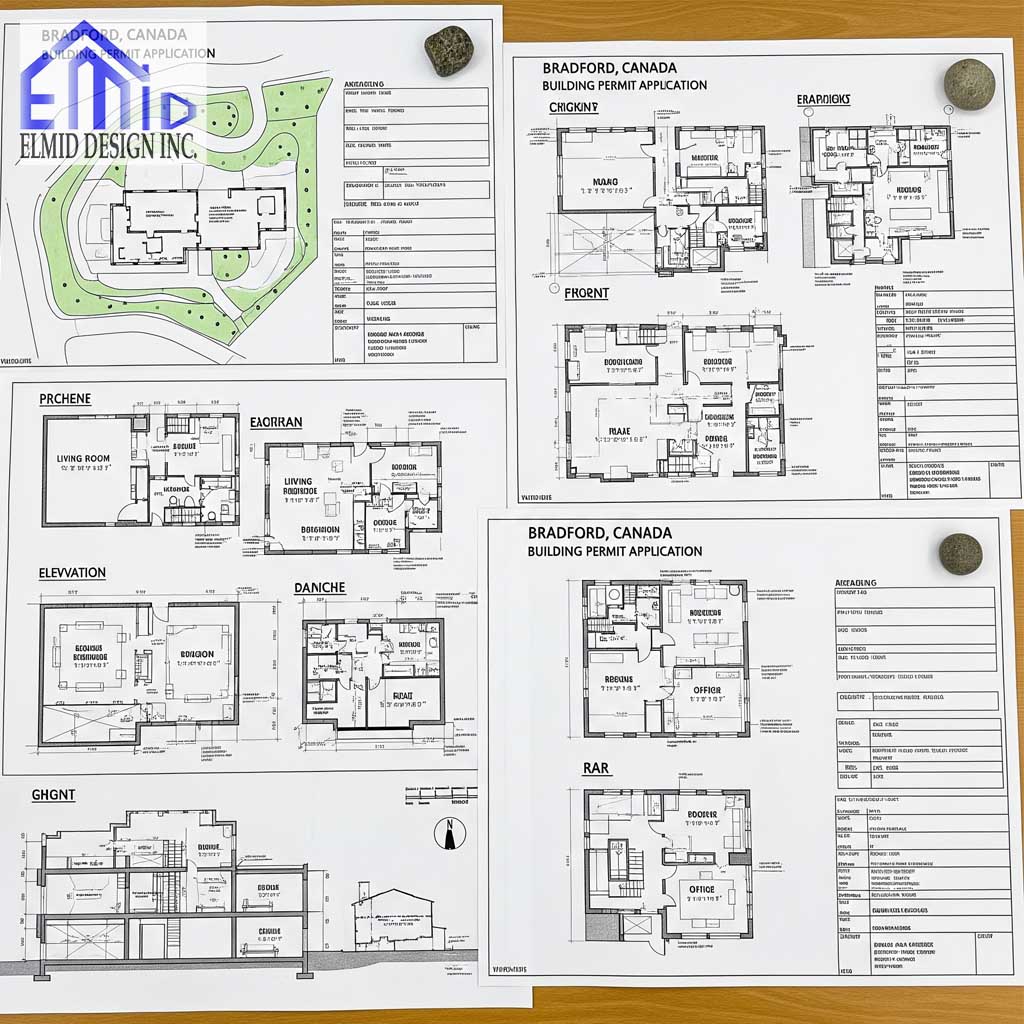Permit drawings in Bradford West Gwillimbury play a crucial role in ensuring your construction or renovation project meets Ontario Building Code requirements and municipal regulations while also safeguarding public safety and zoning compliance. This guide walks you step by step through what drawings are needed, who can prepare them, how to apply properly, and why working with a qualified professional enhances your chances of approval without unnecessary delays. Read on to navigate the process with confidence and clarity.
When Do You Need Permit Drawings in Bradford West Gwillimbury?
You need permit drawings whenever you start most construction or renovation projects. The Town of Bradford West Gwillimbury mandates a building permit before beginning new buildings larger than ten square meters, structural work, excavations, changing building use, or installing on-site sewage systems. You must also check whether a permit from conservation authorities like LSRCA or NVCA is needed before applying.
Which Projects Require Permit Drawings?
Various projects demand detailed documentation in Bradford West Gwillimbury. These include accessory structures above 10 square meters or with plumbing, home additions, basement finishing or apartments, decks attached to the house or more than 107 square feet, demolition, interior alterations, new entrances, new homes, pre-fabricated buildings, septic installations, swimming pool enclosures, and tent structures larger than 60 square meters.
What Must Be Included in Permit Drawings?
A complete permit submission must include clear, to-scale drawings that demonstrate compliance with the Ontario Building Code and local regulations. The application must include site plans, architectural, structural, mechanical, plumbing, electrical, and elevation drawings where applicable. Site plans should show setbacks, grades, property lines, and existing and proposed buildings. Architectural drawings must detail floor plans, use of spaces, wall constructions, roof plans, ceiling plans, and more.
What Documentation Is Required for Different Project Types?
Accessory buildings and structures require a permit form, agent authorization, site and elevation drawings, architectural and structural designs, and conservation authority approval if applicable. Home additions and basement finishing have similar requirements, with specific floor plans showing room sizes, window heights, stairs, detectors, mechanical ventilation, heat registers, and plumbing fixture locations.
Role of Qualified Designers and Professional Stamps
Permit drawings must be prepared by qualified designers. Submissions for certain projects like retaining walls, frost-protected footings, or underpinning require a stamp from an Ontario Professional Engineer. The BCIN directory confirms that Bradford West Gwillimbury requires plans to be created by qualified designers.
Why Permit Drawings Matter for Compliance and Safety
Permit drawings help ensure that your project aligns with local zoning bylaws, Ontario Building Code standards, and structural safety requirements. They support the municipal review process and help expedite permit approvals by demonstrating that your design is legally compliant and structurally sound.
Best Practices for Successful Permit Drawing Submissions
To ensure a smooth process, prepare a complete application with all required forms, drafts, and clear labeling. Confirm whether conservation authority approval is needed early. Work with professionals like those at Acadia Drafting, who offer residential and commercial permit drawing services in Bradford and understand local requirements. Ensuring your drawings meet the checklist requirements significantly reduces rejection risks.
Working With Acadia Drafting for Permit Drawing Services
Acadia Drafting brings over ten years of experience preparing residential, commercial, and industrial permit drawings in Bradford. Their services cover basement renovations, home additions, load-bearing wall removal, decks, garden suites, demolitions, HVAC, and more. Their team ensures your application adheres to building codes and local regulations, with a typical turnaround of two weeks to three months for approval.
Navigating Conservation Authority Requirements
Many permit applications require approval or clearance from conservation authorities such as LSRCA or NVCA, especially for projects near regulated areas. These approvals can take time, so securing them before submitting your building permit is strongly recommended to avoid delays.
Enhancing Your Permit Application with Clarity and Authority
Make sure every component of your application communicates intent clearly. Use accurately scaled diagrams, precise dimensions, and proper annotations. Ensure statements of design or BCIN codes are included, and add geotechnical or energy compliance reports if necessary. Keeping transitions logical and reducing passive language enhances readability and shows professional authority.

Avoiding Rejections and Delays in Bradford’s Permit Process
Submitting incomplete or poorly prepared drawings increases the chances of rejection. Errors in measurements, missing forms, or unclear details often result in lengthy delays. Bradford’s building department carefully reviews every submission for compliance with zoning and construction regulations. To minimize issues, double-check each required element before filing. Include all forms, ensure design accuracy, and provide supporting documents like engineer reports or energy efficiency data when required. This proactive approach demonstrates due diligence and significantly speeds up the process.
Cost Considerations for Permit Drawings in Bradford
Permit drawing costs in Bradford depend on project type, scope, and complexity. Smaller projects such as decks or detached garages may require minimal plans with lower fees, while complex home additions or commercial renovations demand more comprehensive documentation, increasing costs. Professional designers may charge flat fees or hourly rates, depending on service level. However, paying a qualified expert helps avoid costly corrections later. It also strengthens your case for approval by ensuring compliance with current codes and bylaws.
Turnaround Time for Permit Approvals
Bradford West Gwillimbury typically processes permit applications within ten business days for complete submissions. However, incomplete or unclear documents can extend the timeline by several weeks. Some projects, especially those requiring conservation authority review or structural engineering input, can take up to three months to approve. Working with experienced drafting firms helps you avoid delays. They understand submission requirements and local conditions, ensuring smoother coordination between all authorities involved in your project.
What Happens After Permit Approval?
Once approved, construction must begin within six months and not remain inactive for over one year. Inspections are required at key stages, including foundation, framing, insulation, plumbing, and final completion. Failing to schedule inspections as required may void your permit. You must contact the Town of BWG to book each inspection. Keeping your drawings accessible on-site helps ensure each inspector can quickly verify compliance. Smooth inspections result from clear planning and adherence to the approved documents.
The Importance of Site Plans in Permit Drawings
A proper site plan forms the foundation of your permit application. It must show the position of all existing and proposed structures, distances from property lines, driveway locations, lot grading, and any nearby water bodies or regulated zones. This drawing proves your project fits within zoning constraints and environmental conditions. Without a detailed site plan, the municipality cannot assess your compliance. Including an accurate and scaled version from the start helps avoid needless rejections or further requests.
Elmid Design Inc: A Trusted Engineering Firm in Ontario
Elmid Design Inc holds a Certificate of Authorization from Professional Engineers Ontario, allowing them to offer certified engineering and design services across Ontario. Their expertise ensures your permit drawings are both accurate and code-compliant. Their knowledge of Bradford West Gwillimbury’s unique building requirements allows them to help homeowners, builders, and architects obtain approvals without delays. Using a qualified team like Elmid adds professional authority to your project and supports full compliance with engineering standards.
Working With Local Professionals Familiar With Bradford Zoning Rules
Hiring drafting and engineering professionals who understand Bradford’s local bylaws gives you a major advantage. These experts already know what zoning rules apply to specific neighborhoods, lot sizes, and building types. That means fewer revisions, fewer delays, and higher confidence in receiving permit approvals. They also communicate more efficiently with municipal staff and conservation authorities. This local familiarity removes guesswork from your permit submission and provides reassurance throughout your project’s planning and approval stages.
Basement Apartments and Secondary Suites: What to Include in Drawings
For legal basement apartments or secondary suites in Bradford, drawings must show proper exits, ceiling heights, fire separation, smoke and carbon monoxide detectors, natural light, and independent HVAC systems. You must also demonstrate compliance with the Ontario Building Code’s fire protection standards. Adding a separate kitchen and washroom demands detailed plumbing and mechanical drawings. These drawings must prove the space is safe, livable, and independent from the main residence. A poorly planned layout risks immediate rejection.
Load-Bearing Wall Removals and Structural Alterations
Removing structural components like load-bearing walls or beams requires stamped structural drawings from a professional engineer. These drawings must confirm that replacement supports such as beams or posts meet structural capacity standards. They must also show proper bearing points and dimensions. You cannot rely on visual inspections or builder opinions. Only certified engineering drawings are acceptable for permit approval in Bradford. Structural safety cannot be compromised, and engineers like those at Elmid Design Inc ensure it isn’t.
Tips for Submitting Digital Permit Applications in Bradford
Bradford West Gwillimbury allows digital permit applications through its e-permitting portal. Files must be submitted in PDF format with layers flattened and signatures included. File names must follow a specific naming convention. Always review the digital submission guide before uploading documents. Technical errors, missing digital stamps, or improperly labeled drawings often lead to rejections. Preparing documents with guidance from drafting professionals helps ensure you meet the town’s digital submission standards and avoid resubmission delays.
How Zoning Bylaws Affect Permit Drawings
Zoning bylaws in Bradford control building height, lot coverage, setbacks, use of space, and distance from lot lines. These rules must be respected when designing any renovation or new construction. Failure to account for zoning restrictions will result in rejection. A zoning review should happen before drawings are prepared. When drafting your permit documents, you must reflect the current zoning designation and ensure your proposal complies. Professionals who specialize in this field provide valuable guidance.
Garden Suites and Detached Units: Drawing Requirements
As more homeowners consider garden suites or laneway homes in Bradford, clear permit drawings are critical. You must include site plans that show setbacks from property lines, building heights, and access paths. Interior layouts must demonstrate self-contained living conditions, including cooking, sanitation, and sleeping spaces. Mechanical drawings should show independent HVAC, water, and sewage connections. Drawings must prove the unit complies with the Ontario Building Code and zoning regulations. These secondary units add value and income but face strict scrutiny.
Deck Permits and Exterior Additions
In Bradford, you need a building permit to construct a deck larger than ten square metres, attached to the home, or elevated from ground level. Permit drawings must show the deck’s dimensions, support post locations, railing heights, and stair details. The town also requires a site plan showing how the deck connects to the main structure and the distances from property lines. Structural components like beam sizes or footings must meet load-bearing requirements. Including all of these elements ensures approval without delay.
HVAC and Plumbing Drawing Requirements
Mechanical and plumbing drawings are often overlooked during permit applications, yet they form a vital part of most renovation plans. If you add bathrooms, relocate kitchens, or install HVAC in new areas, your drawings must detail ductwork paths, venting, furnace types, and plumbing lines. Bradford officials check whether your mechanical design ensures ventilation, heating, and plumbing flow align with building codes. Including these plans not only satisfies compliance but also prevents future failures or costly retrofits during construction.
Energy Efficiency and Building Code Compliance
Every new build or major renovation must comply with the energy efficiency section of the Ontario Building Code. Your permit drawings should include window U-values, insulation levels, air barrier placements, and mechanical ventilation plans to meet minimum performance standards. Energy modelling or performance path calculations may be required. By incorporating this information into your initial submission, you demonstrate commitment to sustainability and increase the likelihood of approval. Ignoring this step can lead to rejected applications or costly redesigns later.
Legalizing Existing Work Without Permits
If you or a previous owner completed renovations without a permit, you must submit drawings to legalize the work. First, hire a qualified designer to assess current conditions and prepare accurate as-built drawings. After that, submit the documents for retroactive review along with an engineering inspection if structural changes were made. Additionally, you must ensure that all elements meet the current Ontario Building Code. Bradford West Gwillimbury allows this process, provided the work complies with regulations. Ultimately, legalizing unpermitted construction protects property value and helps avoid fines during resale.
Permit Drawings for Commercial Renovations
Commercial projects must meet a wider range of codes, including accessibility, fire protection, ventilation, and occupancy requirements. Drawings must show emergency exits, occupant loads, fire-rated assemblies, mechanical systems, and washroom layouts. Architects and engineers must stamp all drawings. Submissions without these elements usually face immediate rejection. A clear understanding of Ontario’s commercial building codes and municipal bylaws is essential. Professionals like Elmid Design Inc bring both technical accuracy and regulatory experience to ensure your drawings pass every checkpoint.
Updating Drawings After Permit Approval
Changes during construction sometimes require permit drawing updates. You must submit revised drawings showing the updated designs before continuing work. These revisions should clearly mark the changes and remain consistent with previous approvals. Bradford’s building department treats unapproved changes seriously and may issue stop-work orders. Avoiding this issue means regularly communicating with your designer and informing officials of any modifications in layout, structure, or systems. This process ensures your final build remains compliant with all regulatory requirements.
Benefits of Hiring Local Experts for Drawing Preparation
Hiring local drafting and engineering professionals reduces risk and improves efficiency. Experts familiar with Bradford’s submission standards understand exactly what the building department looks for. They know how to meet zoning and conservation rules, organize drawing sets properly, and respond to permit office feedback quickly. These advantages translate into shorter wait times, fewer revisions, and a smoother approval process overall. Professionals like those at Elmid Design Inc maintain strong relationships with local inspectors and planners, further streamlining your project.
How Often Should You Update Permit Drawings?
Drawings should be updated anytime the scope of your project changes significantly. Even minor layout changes, added plumbing lines, or altered structural plans may impact your compliance. It is better to revise your drawings in advance rather than face inspection issues later. Keeping your project documentation current ensures alignment with code, simplifies inspections, and avoids violations. Ignoring this step can delay project completion and increase construction costs. A consistent review process protects both your investment and compliance.
Frequently Asked Questions
What is the role of Elmid Design Inc in Bradford permit drawings?
Elmid Design Inc provides engineering design services certified by Professional Engineers Ontario. They prepare drawings for residential and commercial permits that meet local and provincial standards, ensuring code compliance and structural integrity.
Can I use the same drawings for multiple permits?
Each project and property has unique conditions. Reusing drawings without modifications may result in non-compliance. You must customize each submission based on the lot, zoning, and building design.
Do I need permit drawings for minor renovations?
Even small changes like finishing a basement or removing a wall might require permit drawings if they involve structural, plumbing, or mechanical alterations. Always check with Bradford’s building department before beginning work.
How can I speed up my permit approval in Bradford?
Work with professionals who understand the process, ensure your drawings are complete, include all required forms, and respond quickly to any feedback from officials. Avoiding delays begins with clear, compliant documents.

Why Elmid Design Inc Is Bradford’s Trusted Engineering Firm
Elmid Design Inc is a licensed engineering company with a Certificate of Authorization from Professional Engineers Ontario, offering expert permit drawings and structural design services across Bradford West Gwillimbury. Known for precise, code-compliant plans and quick turnaround times, Elmid helps homeowners, builders, and developers meet local bylaws and Ontario Building Code standards. Their deep knowledge of Bradford’s zoning and construction requirements ensures faster approvals and fewer delays. With a strong reputation built on technical expertise and regulatory compliance, Elmid Design Inc delivers trusted solutions for safe, efficient building projects.
Geographic Locations That We Service:
Our Licensed Professional Engineers specializing in Engineered Site Grading Plans offer the best-engineered site grading plan, lot grading and erosion plan, and drainage plan to obtain site plan approval and building permits in Ontario, including a wide range of municipalities. Each area boasts unique features and requirements, making our tailored approach essential for success.
Toronto and Surrounding Areas
In the vibrant heart of Ontario, we service Toronto (City of Toronto) and surrounding areas. Additionally, we cover Oshawa (City of Oshawa), Pickering (City of Pickering), and Clarington (Municipality of Clarington). Furthermore, our expertise extends to Ajax (Town of Ajax), Whitby (Town of Whitby), Brock (Township of Brock), Scugog (Township of Scugog), and Uxbridge (Township of Uxbridge).
Halton Region
Moving to the Halton Region, our services encompass Burlington (City of Burlington) and Halton Hills (Town of Halton Hills). Also included are Milton (Town of Milton) and Oakville (Town of Oakville).
Peel Region
In the Peel Region, we provide services in Brampton (City of Brampton), Mississauga (City of Mississauga), and Caledon (Town of Caledon).
York Region
Our services in the York Region cover Vaughan (City of Vaughan), Aurora (Town of Aurora), and East Gwillimbury (Town of East Gwillimbury). We also cater to Georgina (Town of Georgina), Markham (City of Markham), Newmarket (Town of Newmarket), Richmond Hill (City of Richmond Hill), Whitchurch-Stouffville (Town of Whitchurch-Stouffville), King (Township of King), and Bradford-West Gwillimbury (Town of Bradford-West Gwillimbury). Each municipality here offers a distinct setting, requiring our specialized approach.
Other Southern Ontario Cities and Towns
We also serve many other cities and towns in Southern Ontario. These include Hamilton (City of Hamilton), St. Catharines (City of St. Catharines), Niagara on the Lake (Town of Niagara on the Lake), Brant (County of Brant), Cambridge (City of Cambridge), Kitchener (City of Kitchener), Waterloo (City of Waterloo), and Woodstock (City of Woodstock). Furthermore, we operate in Guelph (City of Guelph), Centre Wellington (Township of Centre Wellington), Shelburne (Town of Shelburne), Orangeville (Town of Orangeville), New Tecumseth (Town of New Tecumseth), Essa (Town of Essa), Collingwood (Town of Collingwood), Wasaga Beach (Town of Wasaga Beach), Barrie (City of Barrie), Midland (Town of Midland), Orillia (City of Orillia), Ramara (Town of Ramara), Minden Hills (Town of Minden Hills), North Kawartha (Town of North Kawartha), Kawartha Lakes (City of Kawartha Lakes), Peterborough (City of Peterborough), Selwyn (Town of Selwyn), and Brighton (Municipality of Brighton).




